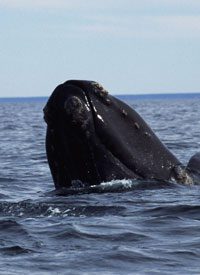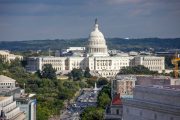
Taken together, the new protected areas from American Samoa to the Mariana Islands to the Rose atoll are larger than Texas. The new status of the area means it will be closed to commercial and most recreational fishing, mineral exploration, waste dumping, under-sea mining, oil drilling, and virtually all other uses, though snorkeling and a few other recreational activities may be permitted with a permit from the federal government.
"For sea birds and marine life, they will be sanctuaries to grow and thrive; For scientists, they will be places to expand the frontiers of discovery; and for the American people they will be places that honor our duty to be good stewards of the Almighty’s creation," Bush said before noting that the military will help keep a look-out for violators. "The new steps I’ve announced today are the capstone of an eight-year commitment to strong environmental protection and conservation."
By declaring the area a national monument, he was able to avoid the year-long process normally associated with creating marine sanctuaries, in addition to providing the highest level of regulatory protection possible under the law. Also, it is permanent, unlike marine sanctuary status which comes up for periodic review. All the waters off the Northwest Hawaiian Islands were already a state marine sanctuary. But proponents of national-monument status argue that federal protection will be even better in preserving the areas’ wildlife, such as albatrosses, and fish along with certain natural features like an unusual sulfur-pool. Most environmentalists praised the move, though many took the opportunity to condemn Bush for not "doing enough" on issues like "climate change." One magazine called Bush "the Teddy Roosevelt of the oceans."
Bush also took the opportunity to announce that the United States will be submitting a request to make the areas a UNESCO World Heritage Site, along with George Washington’s Virginia home, Mount Vernon. "World Heritage sites belong to all the peoples of the world," the United Nations Educational, Scientific and Cultural Organization claims on its website. Hawaii’s governor agrees. "World Heritage sites truly belong to all people of the world," said Republican Governor Linda Lingle while praising the submissions. "They incorporate the most universal and significant aspects of natural and cultural heritage as well as legacy of the past and present for future generations."
But whether the peoples of the world will be able to see or enjoy the areas is another question. Democratic U.S. Representative Ed Case, whose district includes the largely uninhabited islands of Northwestern Hawaii, explained: "We are all going to have to take it on faith that it’s that special, because most of us will never see it, and we never should see it…. We’re just going to have to let it go." He has been lobbying for the designation since he was elected in 2002. The locations were officially proposed by the Marine Conservation Biology Institute and the Environmental Defense Fund, but the Pew Environmental Fund, Laura Bush, Governor Lingle of Hawaii, and James Connaughton, chairman of the White House Council on Environmental Quality, reportedly worked to convince Bush as well.
The designation has had many opponents as well, including government officials from the Mariana Islands, indigenous communities that have fished in the area for generations, and watchdog groups for recreational fishermen. "Without due process or the scientific data to support it, outright bans on recreational fishing in public waters are unacceptable," said Mike Nussman, the CEO of the American Sportfishing Association, which says the move effectively prohibits any recreational fishing within 50 nautical miles of the "monuments."
Nussman continued: "We in the sportfishing community have significant issues with any process where the outcome prohibits people from accessing public resources, particularly when there is no open, transparent process to do so…. There was no proposal or scientific information available for public review and comment."
The president of the Congressional Sportsmen Foundation, Jeff Crane, also criticized the ban, saying: "This presumes that recreational fishing is harmful to these areas when there is no scientific evidence to that affect." He also claims that Bush’s executive decree imposing the ban contradicts a previous executive order that was supposed to protect recreational fishing in public areas.
Chris Horton, the director of BASS Conservation, also weighed in, saying: "We’re disappointed that the president has effectively put the burden of proving that anglers aren’t a problem on the anglers themselves. It’s a very slippery slope to manage natural resources on special interest opinions, rather than scientific justification." He is one of many who believe the designation sets a dangerous precedent. "This clearly circumvents the transparent public process which is required for these things to effectively address resource, social and economic concerns," Horton added.
Even some in government were critical of the move. Kitty Simonds, the executive director of the Western Pacific Regional Fishery Management Council, a federal agency that regulates fishing, wants Congress to amend the Antiquities Act to require congressional approval of proposed monuments. The Antiquities Act states that areas of the monuments are to be confined to the smallest area compatible with proper care and management of the objects protected. In this case we’re apparently talking about more than 300,000 square miles.
And the ban affects not just fishing but any mineral development or oil drilling that might otherwise take place.

